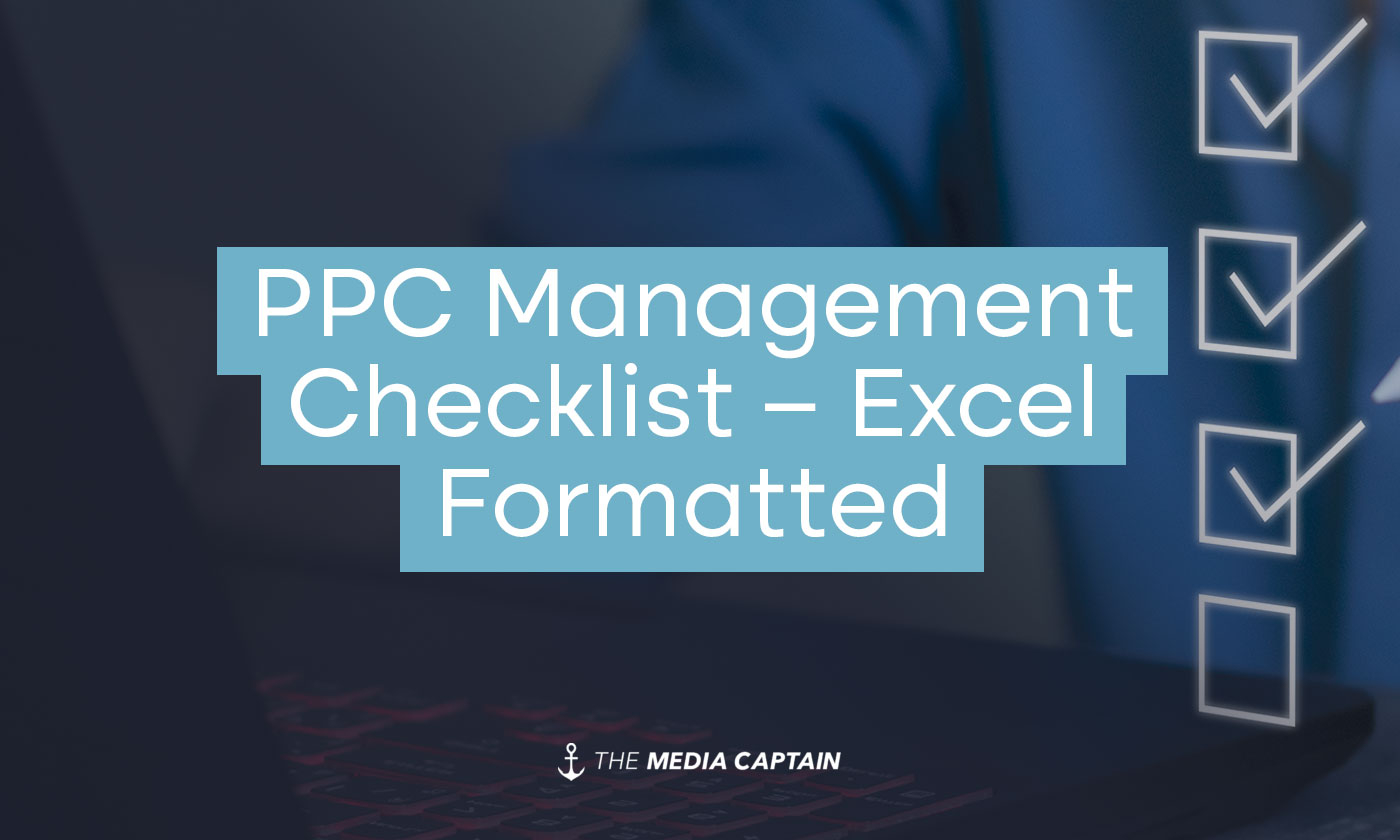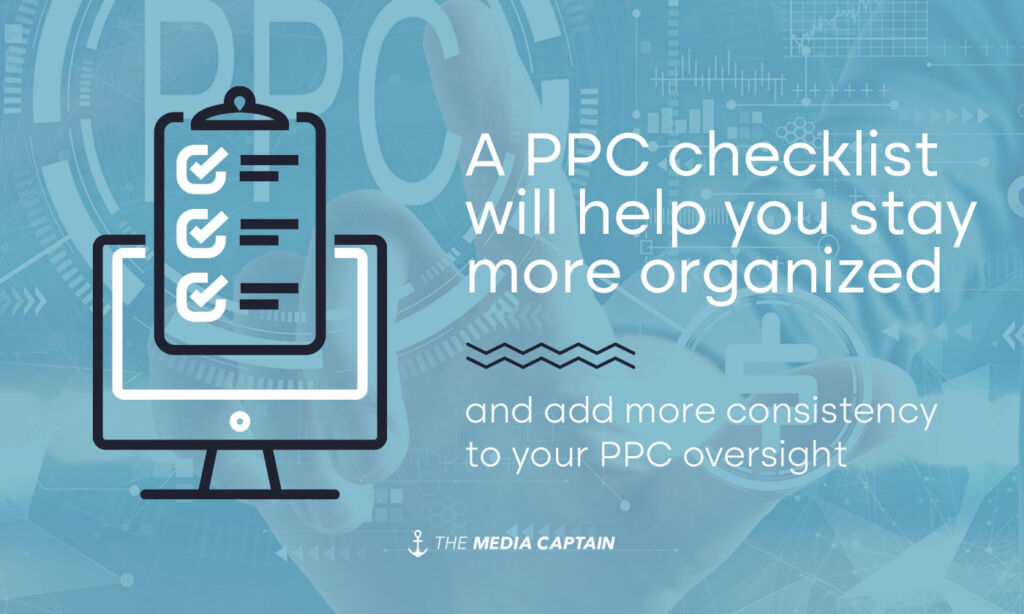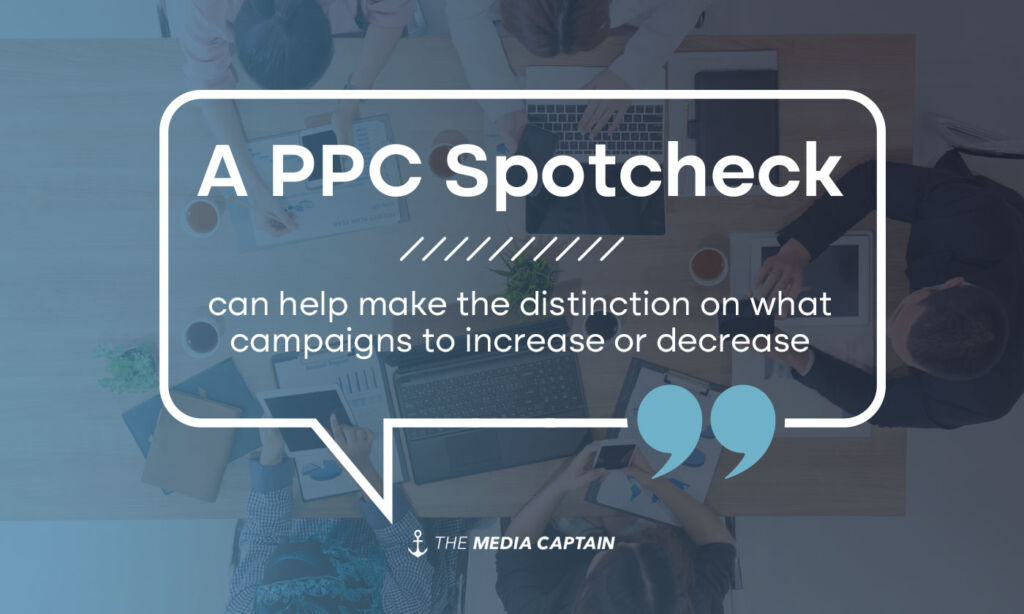When it comes to managing successful pay per click campaigns, oversight is extremely important. From budget to search terms to analyzing data and more, ensuring your campaigns are running smoothly and profitably requires constant management. Our team of paid advertising specialists manages millions of dollars in ad spend for our clients. When it comes to oversight on campaigns, we’ve put together processes to make sure nothing falls through the cracks.
Our PPC checklist will help you stay more organized and fix issues you may have overlooked while adding more consistency to your PPC oversight. This PPC checklist developed by our agency is perfect for a wide variety of business types, which includes the following:
- In-house for a company managing their PPC campaigns
- Agencies managing numerous accounts
- Business owners who feel confident enough to manage your own PPC.
- Managers who have a PPC specialists reporting directly to them.
- Owners who have a PPC specialist reporting directly to them.
Our PPC experts use this checklist for our clients across all verticals. Whether a client has $500 per month in ad spend or $500,000, this checklist can work great for different sized businesses. This can be used as a daily, weekly or monthly checklist, depending on the needs of the business you are managing.
View PPC Checklist in Google Sheets HERE
In addition to the checklist above, I recorded a video that goes into more detailed explanation of what it entails. I also provide extensive detail about the importance of each item on this checklist. If you are managing the day-to-day operations of PPC, you are likely already aware why each item is important (but a reminder won’t hurt). If you are in a management or ownership position overseeing someone else and want to make sure they are doing a good job with PPC management, this will hold them accountable while better informing you as to why each item on this checklist is so important.
Table of Contents
- 1 Deep Dive into the Checklist Process
- 1.1 Objective
- 1.2 Audit Date
- 1.3 Budget Analysis
- 1.4 Search Terms Analysis
- 1.5 Adding Negative Keywords
- 1.6 Keyword Hogs
- 1.7 Increase/Decrease in Conversions
- 1.8 Analysis for Increase/Decrease in Conversions
- 1.9 Hitting Benchmark Conversion Rate
- 1.10 Device Spotcheck
- 1.11 Advertement Spotcheck
- 1.12 Ad Extension Spotcheck
- 1.13 Auction Insights
- 1.14 Google’s Recommendations
- 1.15 Display Ad Checklist
- 1.16 Google Shopping Checklist
- 2 In Closing
Deep Dive into the Checklist Process
Objective
- Each campaign and ad group should have an objective. This is important from a critical thinking perspective. What do you want to accomplish from each specific campaign? To take it a step further, what’s the objective of each ad group? This will allow you to clearly articulate internally or externally what you are looking to accomplish. It allows for high-level conversations to take place between the PPC specialist and the owner or marketing manager to make sure there’s alignment.
- Let’s use a Columbus Dermatologist as an example. If there was a campaign for “Columbus Dermatologist” the campaign objective would be to drive relevant traffic to your site from people in need of a dermatologist throughout all of Columbus. If there was another campaign for “Dermatologist Near Me” the objective would be different. You are looking to drive visitors to your site seeking a dermatologist within a 7-mile radius of your location. We may even have a third campaign for Dermatologist Services, where we have different ad groups based on the services that they offer, such as skin cancer treatment, acne treatment, laser hair removal, and more. You can see that we have three different campaigns, each with a different objective.
Audit Date
- This shows you when the last audit was completed for each ad group. While this can all be found within the change history in Google Ads, we like marking this date within the sheet so anyone can easily look back and reference when the last change was made. This is especially important if you’re sharing the Google sheet with other members on your team from an organization perspective.
Budget Analysis
- Analyze the budget of each campaign. Pay attention to whether you’re limited by budget or if you’re not hitting budget.
- If you’re limited by budget, there’s an opportunity for more reach and you may consider increasing budget. You’ll want to take your conversion rate into account here and also make sure you understand what’s going on within the business. Are more leads coming in? Are you attributing any of the increased business to the ads? Do you have the capacity to take on more business? If so, increase your budget.
- If you’re not hitting budget, you’ll need to dive into the reasoning behind this. Oftentimes, changing the bidding strategy within the campaign can help with this. You may need to adjust your targets or your budgets. Sometimes your bid can be too low, meaning that your exposure may be too low for anyone to see your ads. Make sure your ads are all approved and not restricted in any way. Check to ensure your keywords don’t have low volume. There’s a lot that can be going on to cause your ads to not be hitting budget, so it’s important to continually check this.
- If you are managing a PPC campaign, you have the important distinction of determining whether budget needs increased or decreased. This can either help a company stop bleeding money without conversions. On the other hand, it can help catapult a business scale quickly. In following this PPC checklist, you should be able to make the distinction what campaigns to increase and which ones to decrease and whether or not you should keep the overall budget status quo, lower budget or increase ad spend.
Search Terms Analysis
- We view search terms as the official source of truth of overall quality of your campaign and ad group performance. Yet Google Search terms are oftentimes overlooked by marketers. We wrote this blog on search terms and formulating a negative keyword list. I also recorded THIS PODCAST on the importance of search terms. Bottom line is that search terms are a big deal.
- Within our PPC checklist, it’s important that within each ad group, there’s a search term audit completed. An in-house PPC expert or digital agency can’t perfect search terms without collaboration from internal experts.
- For example, for our in-house eCommerce brand, DermWarehouse, my sister runs the day-to-day operations and is the expert on all of the skincare products. She’s the one that oversees the search terms report like a hawk to make sure no irrelevant search terms come through. Without her expertise, I’d be guessing what’s a low versus a high quality search term. Search terms are just one example of where collaboration between the PPC expert and the in-house product or industry experts is a must.
Adding Negative Keywords
- Once you’ve scoured through the search terms, it’s important to add in the negative keywords at either the account, campaign or ad group level. Adding negative keywords will ensure that your ads don’t trigger for non-relevant searches. I recorded this video on how to add negative keywords into your account.
- Learn More: Master the Google Ads Search Terms Report
Keyword Hogs
- I like to think I coined the term “keyword hog.” Similar to a ball hog in basketball (someone who takes all the shots and doesn’t spread the wealth) a keyword hog is a keyword that eats up the majority of the budget, not leaving enough budget for other keywords. Sometimes there can be a high performing keyword hog that generates a lot of clicks and conversions. In other instances, the keyword hog will scour through the majority of the budget without driving many conversions, decreasing your campaign performance. When you see a keyword hog, there are typically three options:
- Lower the bid (if there’s manual bidding) so it doesn’t generate as many clicks
- Pause the keyword if it’s a low performer
- When a keyword reaches 100 clicks with no conversions, we view this as a sufficient amount of clicks to pause a keyword. Before doing this, we also look back at 90-day history to make sure there aren’t any outliers.
- Create a new ad group or campaign
- It’s not a bad thing to have a single keyword in an ad group that’s converting well. There will be instances when we pause all the other keywords, put them in another campaign or ad group and let our keyword shine. When you have a ball hog like Kobe Bryant or Michael Jordan, sometimes it’s best to move out of the way and let the superstar do their thing!
Increase/Decrease in Conversions
- Look at daily, weekly or monthly conversions versus previous timespans. You’ll want to know if your campaigns, ad groups and keywords are driving more or less conversions vs. the previous period. Depending on your business, you could check this daily, weekly or monthly. There is such a thing as “overmanaging” when you make too many changes to your campaign and not let data properly accumulate. Be patient after you make changes within your account because if you make too many changes all at once, you won’t know what had a positive (or negative) impact. Ultimately, you’ll be measuring conversions (leads, sales, sign-ups, etc.). Checking the increase and decrease on a consistent basis is important.
Analysis for Increase/Decrease in Conversions
- What’s the reason for the increase/decrease in conversions? This is an important critical thinking component with our PPC checklist. If there was similar ad spend, was there more competition compared to the previous month? Was ad copy changed resulting in more conversions with a promo code? If you couldn’t tell, I’m a big football fan. When a team wins or loses, there’s numerous reasons behind this. If the offensive line was great, this led to more rushing yards and more passing yards for the offense. If the offense was scoring at will, it kept the defense off the field longer. The same holds true for PPC. There are so many small changes that can make a big difference. The job of the person managing your campaign should be to articulate this to other key players within your company so there’s alignment on the reason for wins and losses.
Hitting Benchmark Conversion Rate
- We love Optmyzr to track benchmark conversion rate. It’s really tough for someone managing a PPC campaign to manually be spot checking this. Optmyzr allows you to enter a benchmark conversion rate or a benchmark cost per conversion and receive notifications if you’re trending up or down.
- Our PPC spot check provides for a good and consistent way to audit whether cost per conversion per campaign is trending up or down. This is a good time to determine whether to invest more in top performers or divest from poor performers.
Device Spotcheck
- This is another important component to the audit. Adjusting bids based on device often get overlooked yet makes a big difference. You can view your campaign performance by mobile, desktop and tablet devices and you can adjust bids per each device.
- For example, we have a client that sells luxury desks that average over $3,000 per desk. It’s very rare for a product at that price point to be purchased on a phone. The consumer is typically on their desktop at work or at a home office making the purchase. Because of this, we increase our bid on desktop by +25% and we bid down aggressively on mobile, by -75%. This means that if we have a $10 max cost per click, with the adjustment, our max on desktop would be $12.50 and our max bid on mobile would be $2.50.
- We also work with a client that sells protective cases for smartphones, tablets, iPads, etc. This performs very well on mobile because people are literally purchasing something for their phones. We bid up on mobile for this particular client.
- There is a A LOT more volume on mobile than desktop so as a general rule of thumb, we bid down by -10% on mobile. Each client is different and this is something you should always look into during your PPC spotcheck.
Advertement Spotcheck
- What’s the top performing advertisements within each ad group? Are you pausing your poor performers and trying to create new ad copy to outshine your top performers? Checking on the actual advertising copy is very important. If you have two advertisements getting equal budget and one has twice the amount of conversions at half the cost per conversion, you can be losing out on a lot of conversions if you don’t pause the other ad.
- Make sure that each ad group has at least two advertisements so you testing different aspects to see what’s performing best. In hockey, the backup goalie pushes the starter to always perform his/her best. When it’s the backup’s time to play, sometimes they outperform the starter. You should always have a minimum of two advertisements running while making adjustments to maximize on your best performers.
Ad Extension Spotcheck
- “Google ad extensions are, unsurprisingly, an extension of your ads. So instead of having a small blurb of text under an ad, you get more ad space and can go more in-depth about your business. Google ads extensions can improve your search ads because you can provide more value to the content.” [source]
- Sitelinks, callouts, location and call extensions are just some of the extension options Google provides you with. It’s important to make sure these are up and running. There’s also valuable insight you’ll learn from your ad extensions. For example, which sitelink is receiving the highest click through rate and most clicks? Are more people requesting directions or calling directly? Sitelinks are great additional features for your advertisements and you want to leverage them and optimize them.
Auction Insights
- The auction insights report lets you compare your performance with other advertisers who are participating in the same auctions that you are [source: Google]. We always recommend looking at auction insights to determine if you need to increase your bids to gain more exposure. You can look at auction insights at the keyword, ad group or campaign level.
- We also love using auction insights when a client calls in and says, “I’m seeing my competitors ads ahead of mine.” First, we’ll ask them what keyword they were searching for and increase the bid on this so when they search, they’ll be showing up at the top. We will use the auction insights report to inform our client that we actually have a 90% search impression share and a comparable search top impression share whereas their client has a 50% search impression share. This is such a great tool within Google Ads, which is why we recommend looking into this each month for your checklist. Here’s some good vocabulary for you to understand:
- Search impression share: “The percentage of impressions that your ads receive compared to the total number of impressions that your ads could get. Impression share = impressions / total eligible impressions.” [source]
- Search Top Impression Rate: “The percent of your ad impressions that are shown anywhere above the organic search results.” [source]
- Search Absolute Top Impression Rate: “The percent of your ad impressions that are shown as the very first ad above the organic search results.” [source]
- Learn More: Better Understanding Search Impression Share
Google’s Recommendations
- Google makes recommendations within your campaign. Often, these changes can just increase your ad spend without improving performance. Don’t forget, Google is a publicly traded company and is trying to make money! There are a lot of changes within Google’s recommended changes that we don’t agree with such as changing bidding method or adding search partners. That being said, there are items Google will identify that can be helpful, which is why we recommend at least looking through their recommendations. Just remember to take everything with a grain of salt.
Display Ad Checklist
- Are your display advertisements firing off? Do you have a relatively low repeat rate so your ads aren’t being shown to the same person a million times. Have you refreshed creative and messaging within the last 45-days? You’ll want to go through your display retargeting and display ads to make sure they are up-to-date and well optimized.
Google Shopping Checklist
- Google shopping is in a category all its own. We created a separate checklist to help you analyze your Google shopping performance.
In Closing
Following our PPC checklist will make checking your Google ad campaigns a breeze. We’ve built this checklist over many years of optimizing client campaigns. This list holds our team members accountable for the campaigns they’re managing and ensures nothing falls through the cracks. This checklist has helped our team identify opportunities, catch issues and has made management much more manageable.




